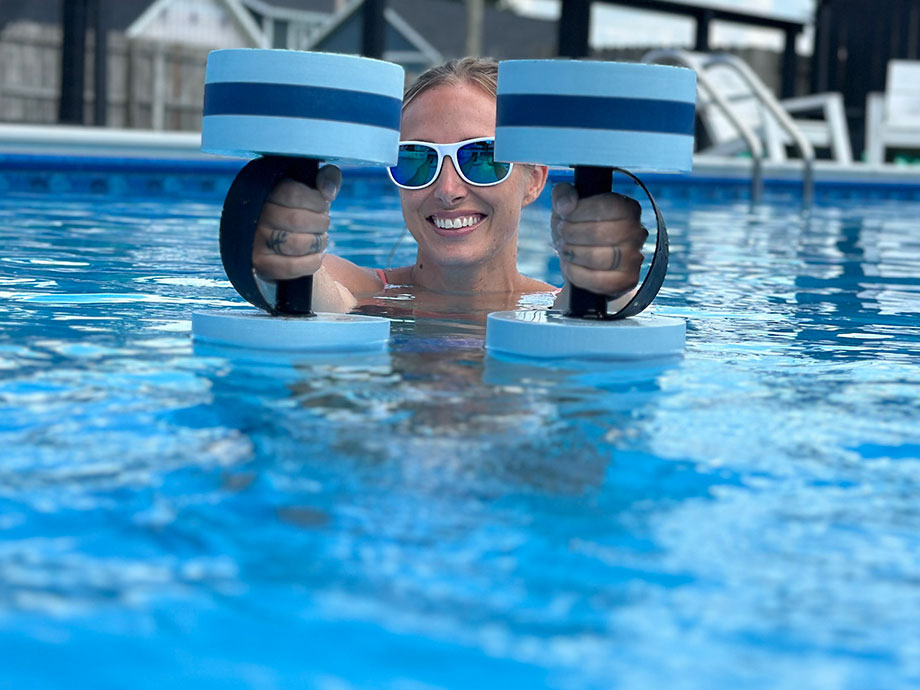We test and review fitness products based on an independent, multi-point methodology. If you use our links to purchase something, we may earn a commission. Read our disclosures.
As much as I love crushing a CrossFit workout or hitting a new PR on the deadlift, sometimes I like to dial things back a bit. After all, a balanced workout plan should include a blend of high-intensity and low-impact exercises that allow you to train your entire body efficiently and effectively.
RELATED: How To Make a Workout Plan
Changing up your environment can be one way to ensure your body and brain get a bit of a break from the ground-and-pound mentality of pumping iron. But just because you’re not in the gym doesn’t mean you can’t continue progressing in your physique, performance, and wellness goals.
While many people view the swimming pool as a place to kick back, relax, and sip on a cocktail, I look beneath the water’s surface and see an endless amount of resistance for full-body workouts. So, how can you best use the buoyancy factor to your advantage?
As a certified personal trainer (CPT), Florida native, and active outdoor enthusiast, I’ve spent plenty of time in the water. Whether you’re working your way back from an injury, looking for water exercise inspiration, or needing a switch-up from your current routine, you can use my curated list of a dozen pool exercises to work on everything from your core muscles to your cardiovascular fitness.
12 Low-Impact Pool Exercises for Effective Water Workouts
While some exercises are limited to solid ground, there are plenty of familiar movements you can perform in the water. In addition to popular side-of-the-pool exercises like dips and push-ups, my list includes several options that allow you to take advantage of the added resistance provided by water.
- Water walk or jog
- Side shuffle
- Jumping jacks
- Flutter kicks (with kickboard)
- High knee jog
- Plank (with pool noodle)
- Triceps extension
- Biceps curl (with water weights)
- Lateral raise (with water weights)
- Pool-edge push-up
- Pool lunge
- Pool squat
Water Walk or Jog
Why do it: A simple form of cardiovascular exercise, water walking is particularly useful if you’re working your way back from an injury.
How to do it:
- Stand in chest-deep water with your body upright.
- Start walking or jogging through the water, driving your knees up high with each step.
- Let your arms swing naturally as you move by maintaining an upright posture.
- Continue for the desired duration or distance.
Expert tip: Using ankle weights will make things more challenging. If you’re looking for a little more intensity, ramp up the pace, and you’ll quickly realize how much slower you feel in the water.
RELATED: Walking For Weight Loss
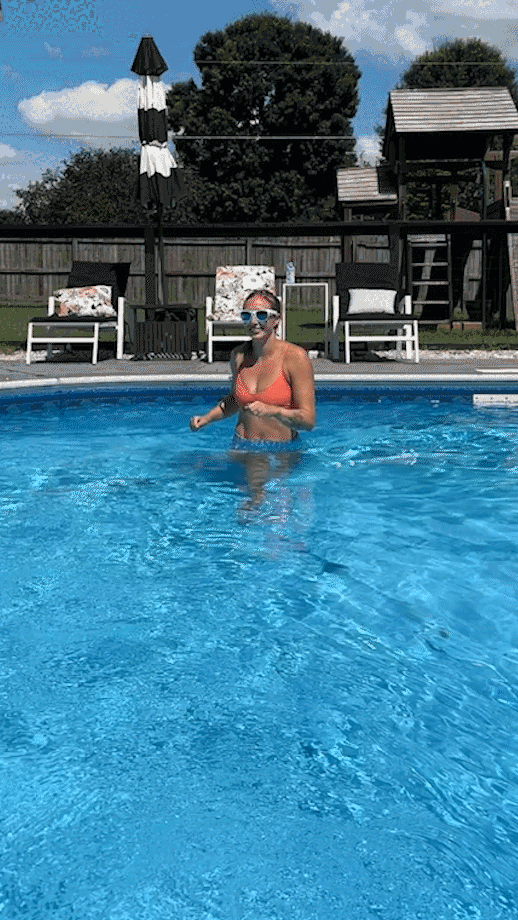
Side Shuffle
Why do it: Working on your lateral agility and coordination using the water’s resistance can help enhance your side-to-side movement skills and lower-body strength. Your quads, hips, glutes, and core must work synergistically to allow you to move smoothly.
How to do it:
- Stand in the pool with your feet hip-width apart and the water at waist to chest level.
- Bend your knees slightly and engage your core.
- Take a step to the right with your right foot, bringing your left foot to meet your right.
- Continue shuffling to the right for a set distance or number of steps.
- Switch directions and shuffle to the left to give both sides an equal amount of work.
RELATED: Agility Exercises
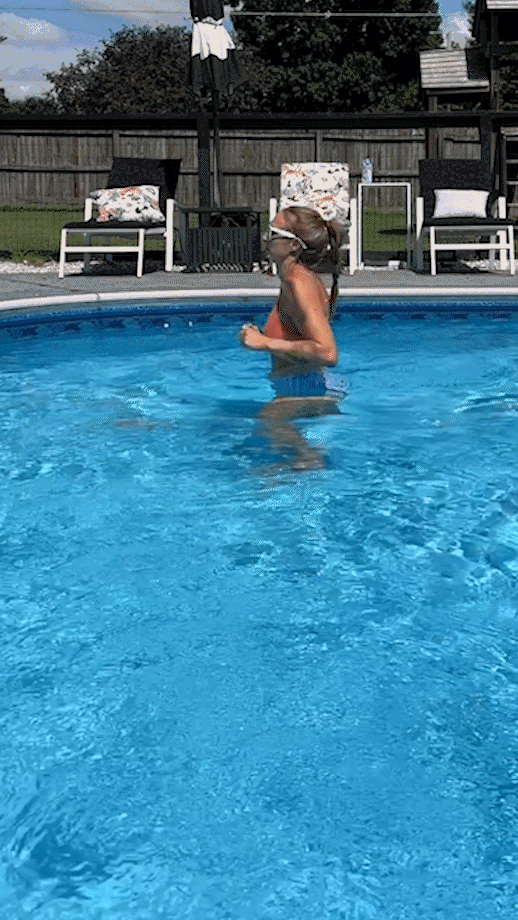
Jumping Jacks
Why do it: A full-body cardio exercise that’s fairly easy on land will feel much different under water. The added resistance will give your arms, legs, heart, and lungs a serious challenge. You can also take jumping jacks to another level using ankle weights for even more resistance.
How to do it:
- Stand in chest-deep water with your feet together and hands at your sides.
- Jump your legs out while bringing your arms together overhead.
- Return to the starting position and repeat for the desired amount of time or repetitions.
RELATED: Cardio Exercises for Beginners
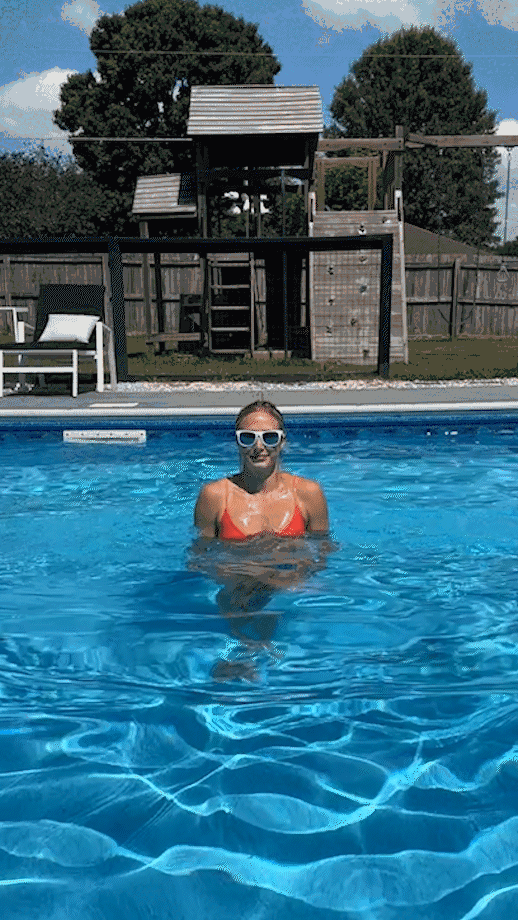
Flutter Kicks (with Kickboard)
Why do it: If you’ve done the supine version in the gym before, you already know flutter kicks are one of the best ab exercises. Not only do they work your hip flexors and core, but they also improve your leg coordination. This version has you flip over onto your stomach, hold onto a kickboard, and fire away.
How to do it:
- Hold onto a kickboard with both hands out in front of you.
- Extend your legs straight out behind you.
- Keep a neutral spine and quickly kick your legs up and down in a fluttering motion.
- Maintain or build speed for the desired amount of time or reps.
RELATED: Functional Core Exercises
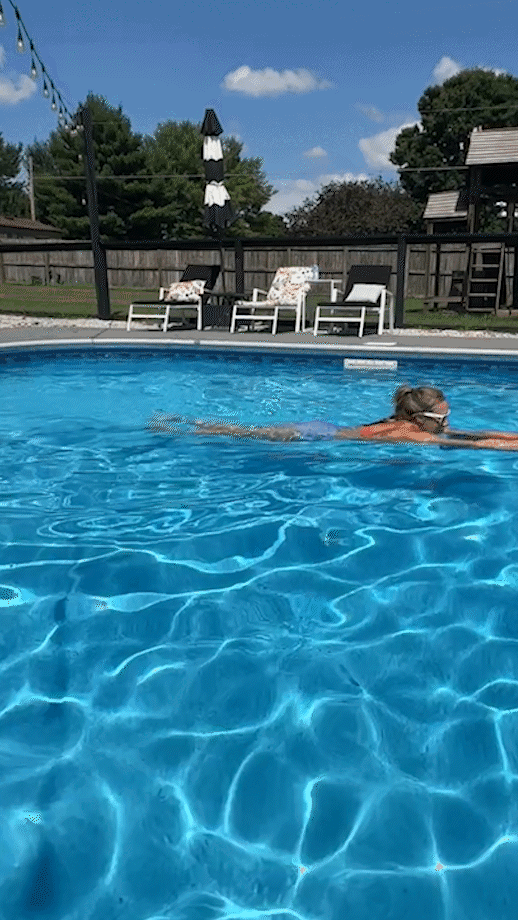
High Knee Jog
Why do it: A great cardio exercise that’s already difficult on land, high knees are even more challenging in the water. The added resistance helps make this movement effective for building lower-body strength and endurance. Plus, the buoyancy of the water reduces the impact on your knees, hips, and ankles.
How to do it:
- Stand in the pool with your feet hip-width apart and the water at chest level.
- Quickly lift your right knee toward your chest as high as possible while keeping your left foot planted on the pool floor.
- Lower your right knee, then immediately lift your left knee toward your chest.
- Continue alternating sides, pumping your arms in sync with your legs to increase the intensity.
- Perform the exercise for the desired amount of time, aiming to maintain a consistent pace from start to finish.
RELATED: Jogging Vs Running
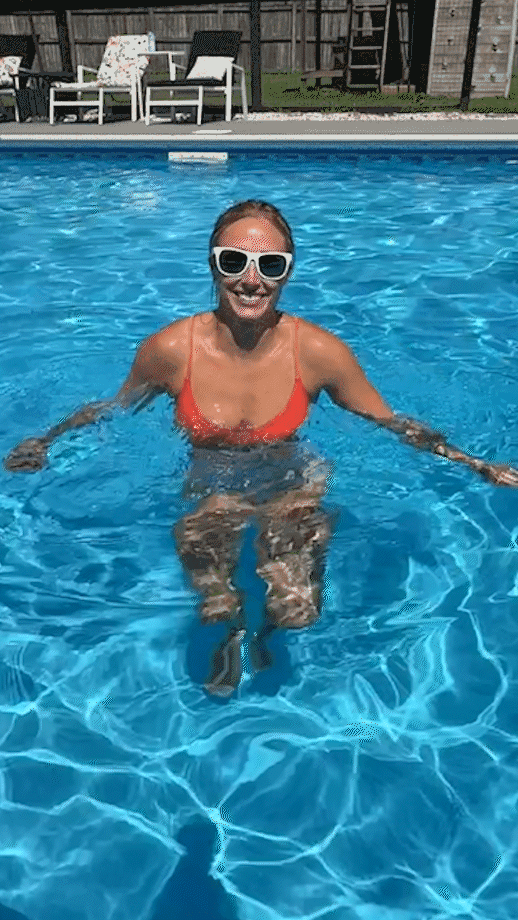
Plank (with Pool Noodle)
Why do it: A core-strengthening exercise that utilizes the water’s buoyancy and resistance to engage your abs, the pool plank requires a noodle and plenty of concentration. While it won’t be as challenging as the land-based version, it still engages your abdominal and lower-back muscles effectively.
How to do it:
- Stand in the pool where the water is at chest level.
- Hold onto a pool noodle placed horizontally in front of you.
- Extend your legs behind you so that your body forms a straight line from head to toe.
- Tighten your abdominal muscles and maintain a neutral spine, holding the plank position for the desired amount of time.
RELATED: Plank Exercises
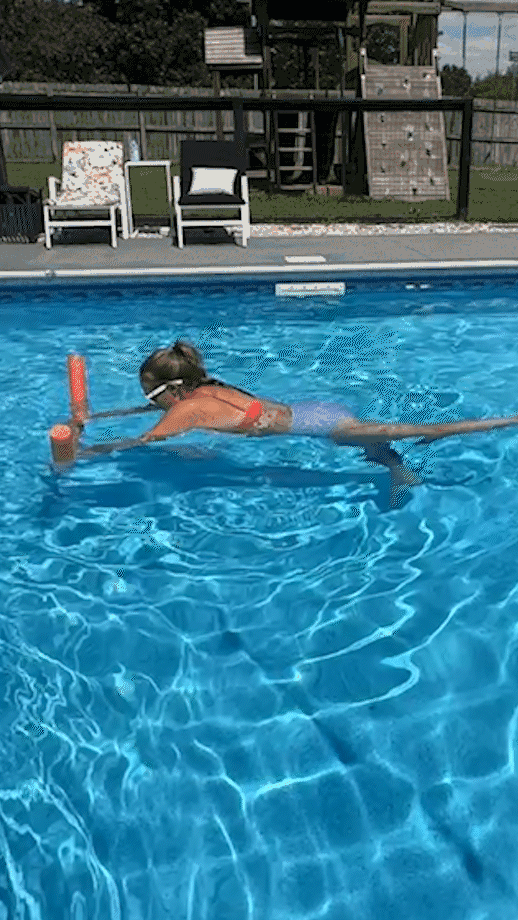
Triceps Extension
Why do it: While you could also do dips using the pool’s edge, the triceps extension also targets your three-headed muscle effectively. This isolation exercise will help you sculpt toned arms that look good in a t-shirt, tank top, bikini, or whatever summertime attire you choose.
How to do it:
- Stand in chest-deep water with your arms by your sides bent at a 45-degree angle.
- Maintain an upright torso, then extend your arms behind you until you lock out your triceps.
- Bend your elbows to return to the starting position.
- Repeat for the desired number of reps.
Expert tip: You can make things more challenging by using water weights for even more resistance.
RELATED: Best Triceps Workouts
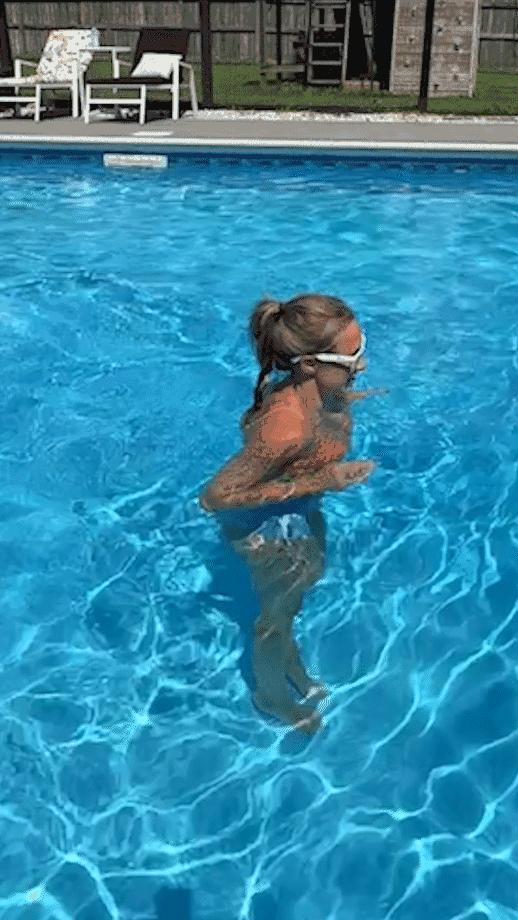
Biceps Curl (with Water Weights)
Why do it: Get ready for your #SunsOutGunsOut moment using water weights. The biceps curl is a classic bodybuilding movement that works well in the gym or the water. Focus on controlled movements and contracting your biceps with every watery rep.
How to do it:
- Stand in the pool so the water is at chest level.
- Hold a pair of water weights by your side.
- Keep an upright torso and curl the weights up to the surface of the water.
- Squeeze your biceps at the top of the movement, then lower the weights back down to your sides.
- Repeat for the desired number of reps.
RELATED: Best Biceps Workout
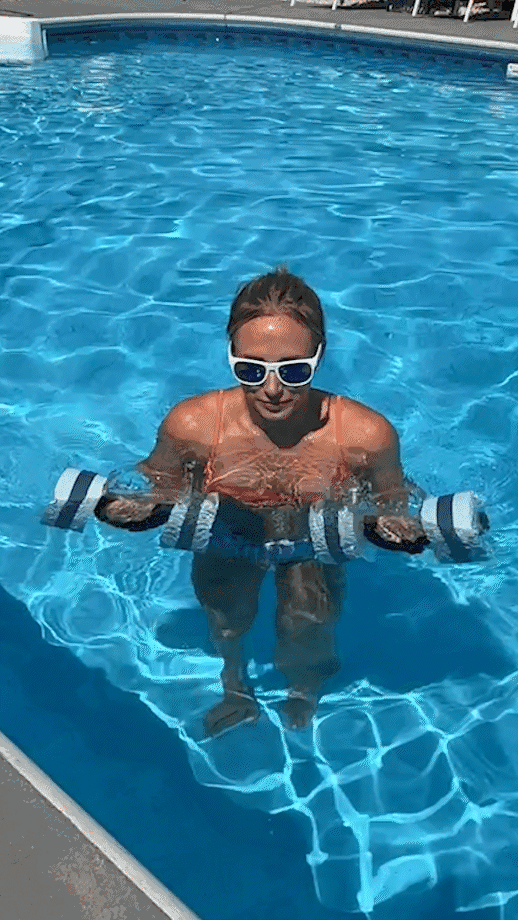
Lateral Raise (with Water Weights)
Why do it: Ready to build boulder shoulders? Use the resistance from both the water and a pair of water weights to get your side delts screamin’ with a pool-based version of lateral raises.
How to do it:
- Stand in water that’s about chest height, holding a water weight in each hand by your sides.
- Take a staggered stance so you can maintain your balance.
- Raise both arms out to your side, bending your knees to lower yourself down until your chin touches the water.
- Squeeze your delts at the top of the movement, then extend your legs and lower your arms back toward your sides.
- Repeat for the desired number of reps.
RELATED: Best Shoulder Exercises
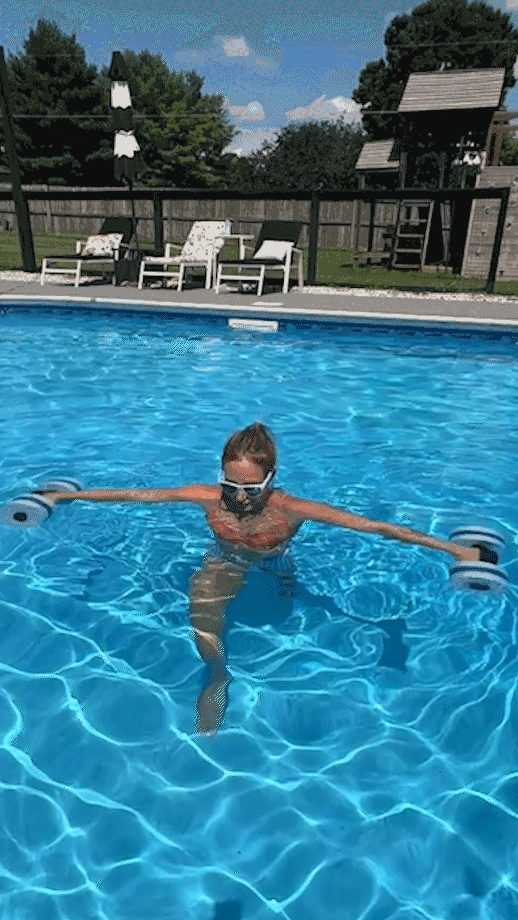
Pool-Edge Push-Up
Why do it: A staple bodyweight exercise that belongs in any fitness program, the push-up is perfectly suited for pool workouts. Beginners can use the edge of the pool to perform an assisted version that takes some of the load off your upper body.
How to do it:
- Stand in the shallow end of the pool and face the wall.
- Place your hands on the edge of the pool so they’re slightly wider than shoulder-width apart.
- Step back so your body forms a straight line from head to toe (like a plank).
- Slowly bend your elbows and lower your chest toward the edge of the pool.
- Hold at the bottom for 1-2 seconds, then push through your palms to straighten your arms and return to the starting position.
- Repeat for the desired number of reps.
Expert tip: Meanwhile, intermediate and advanced trainees can simply step out of the water and use the pool deck to perform various push-up variations.
RELATED: How To Do the Diamond Push-Up
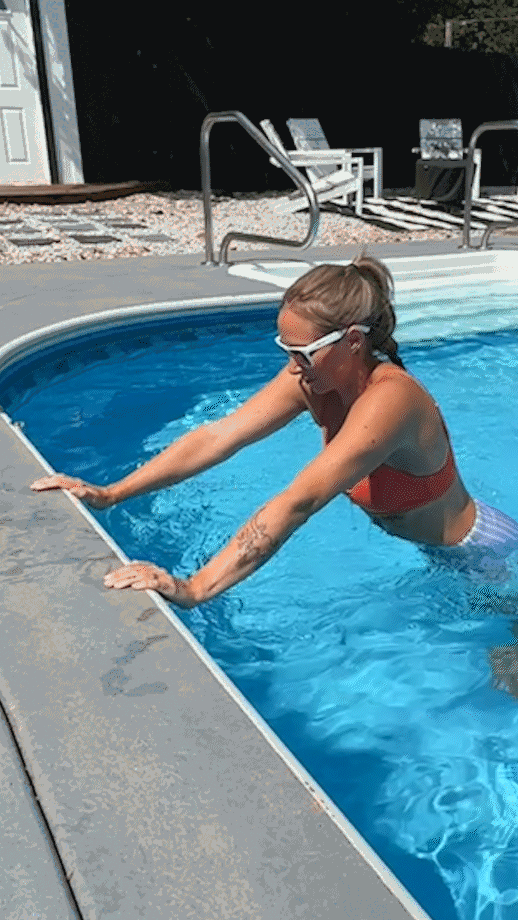
Pool Lunge
Why do it: The lunge is a fundamental movement pattern that can help address muscular imbalances. This unilateral exercise tests your balance and coordination while also providing a cardio challenge.
How to do it:
- Stand in water that’s between waist to chest level with your feet hip-width apart.
- Step your right foot into a lunge position, bending both knees to lower your body.
- Push off explosively with both feet, jumping up in the water while bringing your left leg forward and right leg back.
- Land softly in a lunge position with your left leg forward and right leg back.
- Alternate legs with each jump, making sure to keep an upright torso position.
- Repeat for the desired number of reps or time.
RELATED: Unilateral Exercises
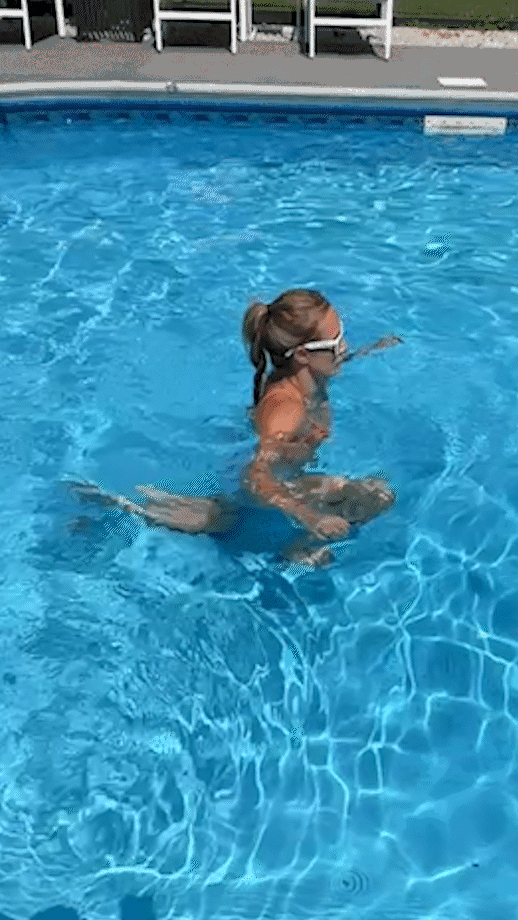
Pool Squat
Why do it: While they’ll never replace back squats with a loaded barbell, you can use pool squats to develop lower-body strength without placing nearly as much stress on your joints. You can also make this movement more dynamic by adding a jumping element.
How to do it:
- Stand in water that’s about waist deep with your feet shoulder-width apart.
- Extend your arms straight out in front of you.
- Lower yourself into a squat position by bending your knees and pushing your hips back.
- Descend until your legs form a 90-degree angle, then drive through your heels to return to the starting position.
- Repeat for the desired number of reps.
RELATED: 21 Best Squat Variations
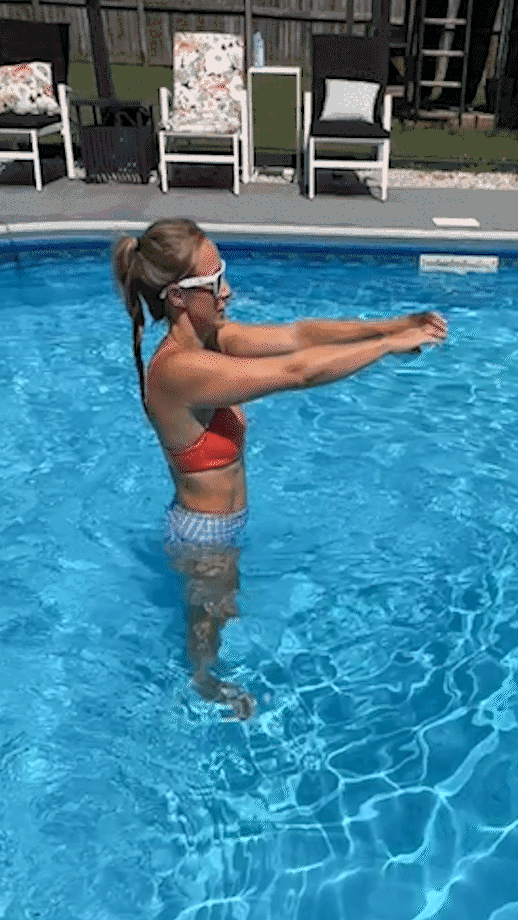
Benefits of Pool Exercises
Why take your workouts to the water? Besides soaking up some much-needed vitamin D, there are several health benefits of incorporating pool exercises into your fitness routine, including:
- They’re much easier on your joints¹, which is particularly important if you’re returning from an injury.
- They provide a cardiovascular challenge, especially if you perform them in a HIIT-style format.
- They help build muscular strength and endurance by using various forms of resistance, including the water itself.
- They’re adaptable to all fitness levels, as you can modify exercises or just use your body weight.
- They don’t require much equipment, which means they’re accessible for budget-conscious fitness enthusiasts.
RELATED: Benefits of Strength Training
What Equipment Do You Need For Pool Exercises?
Just like having the best squat rack can set you up for success in the gym, having the right tools can enhance your aquatic exercise routine. Here’s a rundown of popular pool exercise equipment that can make your water-based workouts safer and more challenging.
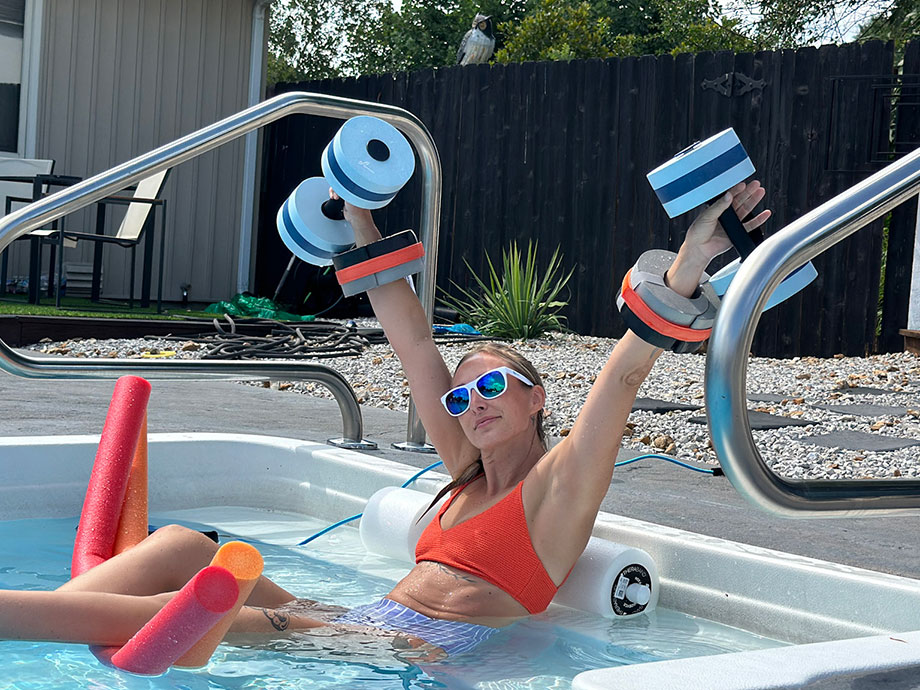
- Ankle weights: Level up your pool leg exercises with weights that wrap around your ankles. Don’t be surprised if adding just a few pounds makes things much more challenging.
- Aqua gloves: Featuring webbed fingers that increase resistance in the water, these specialized gloves can enhance the effectiveness of upper-body exercises.
- Flotation belt: This belt wraps around your waist to help keep you afloat in deep water, allowing you to focus on your form instead of worrying about going under.
- Goggles: You may want to invest in a pair of goggles to keep your eyes protected, especially if you want to add swimming to your workout routine.
- Kickboard: This flat, buoyant board offers a number of uses, including isolating your legs during kicking exercises and providing resistance when submerged for strength training exercises.
- Pool noodle: Although the kiddos may use it for fun instead of fitness, a pool noodle is a versatile tool that can provide support for floating exercises like pool planks.
- Resistance bands: Arguably the most versatile piece of fitness equipment, resistance bands offer just as much value on land as they do at sea—or the pool, in this case. You can anchor bands to the edges of the pool, hold them in your hands, or even wrap them around your legs for strengthening various muscle groups.
- Water dumbbells: While they certainly won’t replace a set of the best adjustable dumbbells, these lightweight foam dumbbells become more resistant when submerged, making them ideal for pool exercises like arm raises and water boxing.
- Water shoes: These shoes provide superior grip on slippery surfaces, protect your feet from getting scraped, and add a little resistance during leg exercises. You can also use them for kayaking, paddle boarding, tubing, fishing, and other water-based activities.
RELATED: How Effective Are Resistance Bands?
Pool Exercise Safety Tips and Precautions
While you don’t need a spotter like you do on the bench press, you still need to prioritize safety when working out in a pool, especially if there’s no lifeguard present. You should have basic swimming skills so you can navigate the pool safely. If you’re working out alone, I also recommend making a family member or friend aware just in case something unexpected happens.
Here are my other safety tips for ensuring your pool exercise routine ends with you walking out of the water with zero worries.
- Be mindful of slippery surfaces: Pool decks can be notoriously dangerous when wet. The last thing you want is to slip and fall before you dip a toe into the water. Walk carefully and consider wearing water shoes for added grip and peace of mind.
- Pay attention to the water depth: Choose the right depth based on the movement and your level of comfort. While some exercises are better suited for the shallow end, others may require greater depth. Don’t wade into the deep end of the pool if you’re not confident you can maintain proper form, either.
- Stay hydrated: Yes, you’re working out in water, but don’t let that fool you into thinking your body doesn’t need more of it. Hydrate before, during, and after your workout. You can also add an electrolyte powder to your water bottle to keep your brain and body functioning optimally.
- Listen to your body: Feeling lightheaded or dizzy? Don’t try to be Aquaman and power through. Ending your workout and getting out of the water is a much better idea than putting your health and safety at risk to knock out a few more pool exercises.
- Don’t skip the warm-up or cool-down: Just like with any type of workout, warm up before you get into your workout. Swim some laps at a casual pace, tread water, or perform dynamic warm-up exercises like high knees and butt kicks to get your blood pumping. Then, cool down once the workout concludes to bring your heart rate back to normal before climbing out of the pool.
RELATED: Cool-Down Exercises
Pool Exercises: Final Thoughts
Whether it’s water aerobics, aquatic strength training, or—ideally—a blend of both, incorporating pool exercises into your fitness routine is a smart way to set yourself up for sustained success in and out of the gym. Although this type of training may not necessarily be the most intense or exciting, it can be a great way to give your joints a well-deserved break.
I’m not saying you have to ditch all your gym clothes for swimwear, but once you dip your toes into the pool exercise waters you may start leaving some room in your schedule for laps, leg lifts, and more aquatic activities.
Pool Exercises: FAQs
Are pool workouts effective?
Yes, pool workouts can be an effective way to enhance your muscular strength and endurance, cardiovascular fitness, flexibility, and coordination without placing too much stress on your joints.
Can you tone your body in the pool?
While you can use the pool as a tool to help burn calories and tone your body, I still recommend performing at least two weekly strength training sessions to provide a sufficient muscle-building stimulus. A balanced workout plan that includes cardio and resistance training and a well-formulated diet will allow you to achieve a strong, lean physique.
RELATED: Body Recomposition
Are there any risks to pool exercises?
While most pool exercises are generally safe, you must be mindful of several factors, including wet surfaces, water depth, overexertion, and dehydration. Carefully exit the pool if you feel dizzy or lightheaded. If possible, perform your workouts in a pool with a lifeguard present.
What is the best pool exercise for someone with knee pain?
As a certified personal trainer, I’d recommend water walking or water cycling for someone suffering from knee pain. Both are low-impact forms of cardiovascular exercise that can help strengthen the muscles around the knee and improve your mobility.
References
- Kutzner, I., Richter, A., Gordt, K., Dymke, J., Damm, P., Duda, G. N., Günzl, R., & Bergmann, G. (2017). Does aquatic exercise reduce hip and knee joint loading? In vivo load measurements with instrumented implants. PloS one, 12(3), e0171972. https://doi.org/10.1371/journal.pone.0171972
Further reading

Our Eleiko Evo dumbbell review will explore why the best free weight isn’t always the best choice for home gyms. Read more

We expose a handful of treadmill features we’d like to see improved in our Echelon Stride 8s review. Read more

If your training demands require it, a carb supplement can help boost your energy at opportune times. Below, our expert rounded up the best carb supplements for your needs. Read more

This Home Chef review explores the enduring and popular home meal delivery service to answer the question: is Home Chef worth it? Read more

